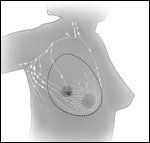ASCO: An Epidemic of Contralateral Prophylactic Mastectomy
While overall mastectomy rates have dropped in recent years, more and more women with cancer in one breast are opting to have both breasts removed. The trend has left many researchers questioning whether contralateral prophylactic mastectomy (CPM) is getting overused, or if it simply reflects a better recognition by both patients and physicians of who is likely to develop breast cancer.
While overall mastectomy rates have dropped in recent years, more and more women with cancer in one breast are opting to have both breasts removed. The trend has left many researchers questioning whether contralateral prophylactic mastectomy (CPM) is getting overused, or if it simply reflects a better recognition by both patients and physicians of who is likely to develop breast cancer.

Total (simple) mastectomy
The answer is likely the former, according to Monica Morrow, MD, of Memorial Sloan-Kettering Cancer Center in New York, NY, who presented a range of relevant findings at the American Society of Clinical Oncology (ASCO) Annual Meeting in Chicago.
"The majority of women having CPM are not at a high risk for developing a second breast cancer," she told the audience on Monday.
In fact, as she noted, contralateral cancer has declined dramatically over the last few decades: less than 0.5% of breast cancers now spread to the second breast.
One recent study conducted at Dr. Morrow's home institution, and published online in the Journal of Clinical Oncology in April 2011 (doi: 10.1200/JCO.2010.29.4041), reflects this phenomenon. Between 1997 and 2005, she and her colleagues evaluated 2,965 women with stage 0 to III primary unilateral breast cancer who underwent mastectomy.
Within a year of treatment for their index cancer, 13.8% of the women underwent CPM-with rates increasing from 6.7% in 1997 to 24.2% in 2005.
Only 57 (13%) of these 407 women were actually at an increased risk for a second breast cancer based on BRCA or family history.
Dr. Morrow and her colleagues found strong associations between the use of CPM and women having an MRI at diagnosis, an immediate reconstruction, a benign biopsy on the unaffected breast, noninvasive histology, or a prior attempt at breast conservation. Women younger than 50 years old and surgeon-identified white race were also predictors of CPM.
But is it still possible to justify this rise in use? Perhaps the aggressive surgery does improve survival or patient satisfaction?
Probably not, suggested Dr. Morrow.
A separate study published in the Journal of National Cancer Institute in March 2010 reported minimal improvement in 5-year breast cancer-specific survival associated with CPM. The benefit was mainly confined to young women with early-stage ER-negative breast cancer: 88.5% of those undergoing CPM compared to 83.7% of those that did not (doi: 10.1093/jnci/djq018).
Further, Dr. Morrow pointed to a study of 910 breast reconstructions at Memorial Sloan-Kettering, published in the journal Plastic and Reconstructive Surgery in April 2011 (doi: 10.1097/PRS.0b013e318208d12a). Her team reported similar general and aesthetic satisfactions scores between women who underwent unilateral and bilateral mastectomy.
All of these findings beg the question of why women are putting themselves through this procedure, said Dr. Morrow. Earlier at this year's ASCO meeting, she and her colleagues offered a few guesses (abstracts 6010 and 6021).
In their longitudinal survey of 707 women, about 9% underwent CPM; more than 80% of them did not meet high-risk criteria.
They discovered that a woman's mental state had a strong influence on her treatment choice. The odds of being worried about recurrence were about 3 times higher in the CPM group than among women who did not undergo the surgery.
"In this era of increased restriction on health care spending," noted Dr. Morrow, "is surgery to relieve patient anxiety even ethical?"
"The reasons that patients choose CPM are poorly understood," she added. "How effectively CPM meets those needs is even less well understood. We sorely need high quality prospective research."